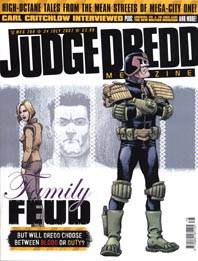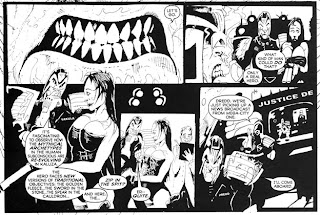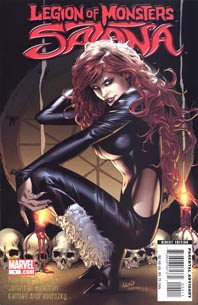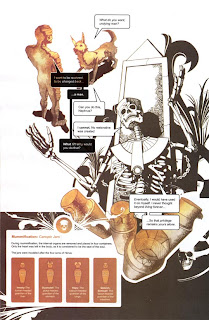 Judge Dredd Megazine issue 260, edited by Matt Smith, cover art by Peter Doherty, 40 pages of strip, £2.99, Rebellion, 24 July 2007
Judge Dredd Megazine issue 260, edited by Matt Smith, cover art by Peter Doherty, 40 pages of strip, £2.99, Rebellion, 24 July 2007Features Judge Dredd “Night School” by John Wagner (script) and Peter Doherty (art and letters)
Anderson, Psi Division “Big Robots” part 4 by Alan Grant (script), Dave Taylor (concept and art) and Ellie de Ville (letters)
Judge Dredd “Blood of Satanus III: The Tenth Circle” chapter 4 “Hungry Jacko” by Pat Mills (script), Hicklenton (art) and Simon Bowland (art)
Freak Show “The Quiet Man” by Robert Curley and Declan Shalvey
“The God Fish” by Mike Collins (script), Chris Weston (art) and Tom Frame (letters) (reprinted from 2000AD)
The Angel Gang “Before They Wuz Dead” part 3 by Simon Spurrier (script), Steve Roberts (art) and Ellie de Ville (letters)
The highlights of this issue are Dave Taylor’s cityscapes in “Big Robots” – a story about a mad architect whose city blocks are actually giant robots now going on a pre-programmed rampage – and Steve Roberts’ cartoonish but gritty artwork on The Angel Gang.

But all the Dredd material here feels a little tired, an impression reinforced by Pete Doherty’s competent but mundane artwork on “Night School”. I wish I could say it was inappropriate, but Wagner's story about Dredd getting his clone Dolman acquitted of a manslaughter charge is equally dull. Perhaps thirty years of mining the Judge Dredd background weekly in 2000AD and, latterly, in several stories a month in the Megazine, have left it played out?
“The God Fish” is a routine twist-ending Future Shock, distinguished only by Chris Weston’s artwork. Freak Show is a small press showcase story about a police entrapment operation, which shows that Curley and Shalvey have promise, but are still a little clumsy in pacing and dialogue.
But all of this is preferable to “Blood of Satanus”, a farrago of ugly, over-emphatic and sloppy writing and drawing by two long-established comics professionals.

Articles this issue lead with part 2 of a history of horror comics, this time concentrating on British comics, especially the horror-inflected material in 2000AD and US-published comics by UK creators from Swamp Thing to Gutsville. I found odd the statement that “2000AD had only one explicit horror serial” before Andy Diggle’s time as editor (Fiends of the Eastern Front). What about Shako (basically Jaws but with a polar bear), or the early story about an army of ants eating its way across South America?
There’s also an interview with Carl Critchlow, mostly about his work as writer/artist on Thrud the Barbarian; an article noting the latest wave of British comics writers and artists working in the US; a short piece advising small press creators on how to prepare for comics conventions; some film reviews; and the 27th part of an annotated index of the Judge Dredd stories in 2000AD. They’ve only reached Prog 277 (out of 1543 to date), but still haven’t found room to include any publication dates.
I don’t buy the Judge Dredd Megazine very often. This issue reminded me why.
 Legion of Monsters: Satana issue 1, cover by Greg Land, 28 pages of strip, US$2.99, Marvel Comics, August 2007
Legion of Monsters: Satana issue 1, cover by Greg Land, 28 pages of strip, US$2.99, Marvel Comics, August 2007Features Satana “Satana and the Electric Pentacle” by Robin Forth (writer), Kalman Andrasofszky (art), Stephane Pero (colour), VC’s Rus Wooton (letters) and John Barber (editor)
The Living Mummy “Must Die / Eat Soul” by Jonathan Hickman (story and art) and John Barber (editor)
Believe it or not, the character on the cover, the Devil’s daughter Satana, actually criticises someone else’s fashion sense in this issue, despite being dressed herself in Vampirella’s cast-offs. That apart, the lead story here, in which a woman learns that making a deal with Satan’s daughter can be a tricky business, is an OK time-passer. But the reason for buying this issue is in the back of the comic.
For The Living Mummy, Jonathan Hickman brings to bear on Egyptianate horror the informatic style he developed for modern media tale The Nightly News. Each page is a single illustrative unit (except for one integrated double-page spread), and the dialogue is interspersed with box-outs giving background information.

You might expect this approach to be too dry and modern to suit a historical horror story, but Hickman uses more a more decorative style here than in The Nightly News, and conjures up the heat of the Nile valley with his choices of brown and orange colours. It works surprisingly well. As the story is a basic origin retelling, the interest is all in this technique.
No comments:
Post a Comment